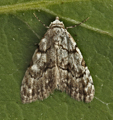2022 Annual Report for: Nolidae / Nolinae
For species seen in 2022 that had less than or equal to 100 records, full details are included; for more common species, the earliest, latest and highest count by vice-county are shown. The narrative for each species is taken from the main Hantsmoths website, and it is possible that some information on abundance and occurrence can get out of date, as it is impossible to keep up with all changes; however it should give a good introduction to each species. The tables in each species account summarise the previous status, and that for the current year.
For the maps, all records prior to 2022 are shown by a blue dot (the larger the dot, the more recent), with the current year's records shown in red. As previous records are superimposed on any report for 2022, new sites have greater emphasis (i.e. will show as 'more red').
In the species accounts, an asterisk next to a location indicates a new 10km square record; earliest ever dates are highlighted in orange, and latest ever in red. Initials in the species accounts refer to the recorders listed here. Please get in touch if you identify any omissions or errors, in particular if you have records that have yet to be submitted. Details of how to submit records can be found here.
74.001 [B&F: 2075] Small Black Arches Meganola strigula ([Denis & Schiffermüller], 1775) - Nationally Scarce
Nationally scarce (Na) in oak woodland in southern England. In Hampshire and on the Isle of Wight moderately common in the large oak woods - Parkhurst Forest, the New Forest, Harewood and Pamber Forests; very occasional elsewhere. Wingspan 18-24 mm. Similar to Least Black Arches N. confusalis, but Small Black Arches lacks the prominent dentations on the median fascia of forewing (MBGBI Vol 9). Larva feeds on Pedunculate Oak.
Records prior to 2022
| Vice County | #Records | #Individuals | First Record | Last Record |
|---|---|---|---|---|
| 10 | 19 | 6 | 1800 | 2019 |
| 11 | 173 | 164 | 1800 | 2021 |
| 12 | 94 | 207 | 1800 | 2021 |
2022 records
| Vice County | #Records | #Individuals | Max Quantity |
|---|---|---|---|
| 10 | 2 | 5 | 4 |
| 11 | 4 | 14 | 6 |
| 12 | 3 | 16 | 8 |
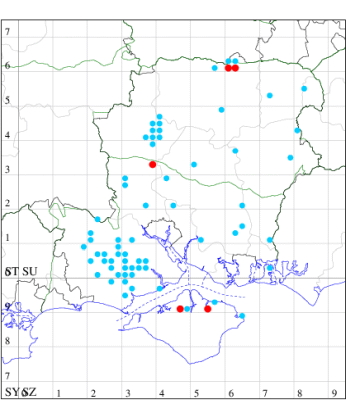
Records by year
Records by week (adult)
Records by week (larval)
Record Details
VC10: Parkhurst Forest, four, 02 Jul (IOu); Wootton Bridge, one, 29 Jun (DElm); Parkhurst Forest, four, 02 Jul (IOu); Wootton Bridge, one, 29 Jun (DElm);
VC11: Winter Down Copse, Little Somborne, three, 17 Jun; three, 17 Jun; six, 17 Jun; two, 17 Jun (GCE); Winter Down Copse, Little Somborne, three, 17 Jun; three, 17 Jun; six, 17 Jun; two, 17 Jun (GCE);
VC12: Pamber Forest, eight, 17 Jun; seven, 11 Jul; one, 10 Jul (GJD)Pamber Forest, eight, 17 Jun; seven, 11 Jul; one, 10 Jul (GJD)
74.002 [B&F: 2076] Kent Black Arches Meganola albula ([Denis & Schiffermüller], 1775) - Nb
Nationally scarce (Nb) on heathland, saltmarshes, shingle beaches, sandy beaches, chalk downland and woodland clearings, in south-eastern England, predominantly coastal, but increasing in recent years inland in central southern England. In Hampshire and on the Isle of Wight widespread but uncommon near the coasts of vice-counties 10 and 11, becoming rather more common in vice-county 12 in recent years. There was a marked increase in the number of records received in 2009. Wingspan 18-24 mm. The most likely confusion species is Scarce Black Arches Nola aerugula. Larva feeds on Dewberry, Bramble, Raspberry and Wild Strawberry.
Records prior to 2022
| Vice County | #Records | #Individuals | First Record | Last Record |
|---|---|---|---|---|
| 10 | 269 | 410 | 1900 | 2021 |
| 11 | 1191 | 1547 | 1800 | 2021 |
| 12 | 192 | 234 | 1950 | 2021 |
2022 records
| Vice County | #Records | #Individuals | Max Quantity |
|---|---|---|---|
| 10 | 39 | 69 | 10 |
| 11 | 81 | 108 | 6 |
| 12 | 21 | 55 | 18 |
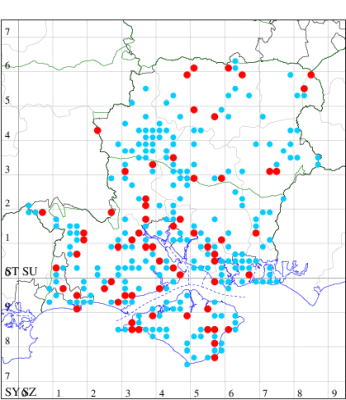
Records by year
Records by week (adult)
Records by week (larval)
Record Summary
VC10: Earliest: Totland, 26 Jun, 1 (RTer) Latest: Bonchurch, 09 Oct, 1 (JHa) Max count: West High Down quarries, 12 Jul, 10 (IOu)
VC11: Earliest: Woodley, 11 Jun, 1 (NBin) Latest: Funtley, 30 Jul, 1 (TDC) Max count: Needs Ore NNR, 10 Jul, 14 (CNB)
VC12: Earliest: North Waltham, 29 Jun, 1 (AJon) Latest: Blackwater, 27 Jul, 1 (BGD) Max count: Fleet Pond, 06 Jul, 18 (MHals)
74.003 [B&F: 2077] Short-cloaked Moth Nola cucullatella (Linnaeus, 1758) - Common
Common in hedgerows, gardens, scrub and woodland throughout much of Britain. In Hampshire and on the Isle of Wight still widespread and fairly common in all three vice-counties. Wingspan 15-20 mm. The easiest of the Nolidae to identify, and one of the most common. Larva feeds on Hawthorn, Midland Hawthorn, Blackthorn, Apple, Pear and Plum.
Records prior to 2022
| Vice County | #Records | #Individuals | First Record | Last Record |
|---|---|---|---|---|
| 10 | 166 | 204 | 1978 | 2021 |
| 11 | 1410 | 1783 | 1951 | 2021 |
| 12 | 391 | 397 | 1951 | 2021 |
2022 records
| Vice County | #Records | #Individuals | Max Quantity |
|---|---|---|---|
| 10 | 17 | 21 | 2 |
| 11 | 28 | 58 | 18 |
| 12 | 18 | 20 | 3 |
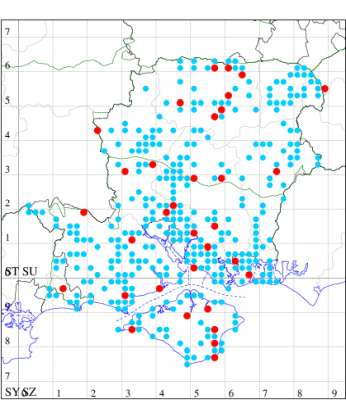
Records by year
Records by week (adult)
Records by week (larval)
Record Summary
VC10: Earliest: Bonchurch, 17 Jun, 1 (JHa) Latest: Bonchurch, 15 Jul, 1 (JHa) Max count: West High Down quarries, 12 Jul, 2 (IOu)
VC11: Earliest: Needs Ore NNR, 07 Jun, 1 (CNB) Latest: Funtley, 11 Aug, 1 (TDC) Max count: Brownwich cliffs, 17 Jun, 18 (RJD, MLO, ADT, DWal, KJW)
VC12: Earliest: Pamber Forest, 17 Jun, 1 (GJD) Latest: Basingstoke, 19 Jul, 1 (MJW) Max count: Cheriton, 12 Jul, 3 (DAS)
74.004 [B&F: 2078] Least Black Arches Nola confusalis (Herrich-Schäffer, 1847) - Local
Local in woodland, hedgerows, parks, orchards and gardens throughout the British Isles. In Hampshire and on the Isle of Wight widespread and fairly common in oak woodland, though evidently less frequent than formerly. Wingspan 16-24 mm. Could be confused with Small Black Arches Meganola strigula, but M. strigula has more dentate median fascia. Larva feeds on Downy Birch, Blackthorn, Buckthorn and Lime, over-wintering as a pupa.
Records prior to 2022
| Vice County | #Records | #Individuals | First Record | Last Record |
|---|---|---|---|---|
| 10 | 388 | 721 | 1929 | 2021 |
| 11 | 1522 | 1770 | 1951 | 2021 |
| 12 | 459 | 579 | 1951 | 2021 |
2022 records
| Vice County | #Records | #Individuals | Max Quantity |
|---|---|---|---|
| 10 | 51 | 132 | 10 |
| 11 | 79 | 140 | 11 |
| 12 | 44 | 57 | 3 |
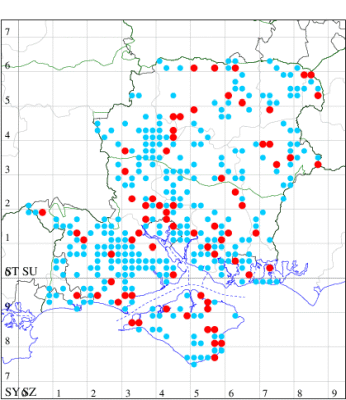
Records by year
Records by week (adult)
Records by week (larval)
Record Summary
VC10: Earliest: Bonchurch, 23 Mar, 1 (JHa) Latest: Bonchurch, 01 Jun, 2 (JHa) Max count: Osborne Valley Walk, 09 May, 10 (IOu)
VC11: Earliest: Holidays Hill Inclosure, 14 Apr, 2 (AMD) Latest: Romsey, 11 Jul, 1 (NRJ) Max count: West Meon, 06 May, 11 (RJD, MLO, DWal, KJW)
VC12: Earliest: Alton, 21 Apr, 1 (EFig) Latest: Hammer Vale, Woolmer, 18 Jun, 1 (ASwa) Max count: Barton Stacey, 03 May, 3 (GCE)
